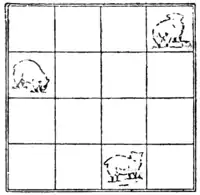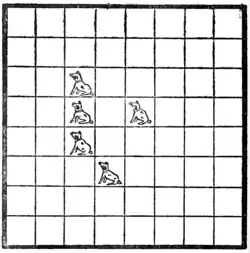92
AMUSEMENTS IN MATHEMATICS.
He will most likely be twopence short of the maximum. A friend asked the Post Office how it was to be done; but they sent him to the Customs and Excise officer, who sent him to the Insurance Commissioners, who sent him to an approved society, who profanely sent him—but no matter.
309.—THE FORTY-NINE COUNTERS.
| A1 | A2 | A3 | A4 | A5 | A6 | A7 |
| B1 | B2 | B3 | B4 | B5 | B6 | B7 |
| C1 | C2 | C3 | C4 | C5 | C6 | C7 |
| D1 | D2 | D3 | D4 | D5 | D6 | D7 |
| E1 | E2 | E3 | E4 | E5 | E6 | E7 |
| F1 | F2 | F3 | F4 | F5 | F6 | F7 |
| G1 | G2 | G3 | G4 | G5 | G6 | G7 |
Can you rearrange the above forty-nine counters in a square so that no letter, and also no number, shall be in line with a similar one, vertically, horizontally, or diagonally? Here I, of course, mean in the lines parallel with the diagonals, in the chessboard sense.
310.—THE THREE SHEEP.

A farmer had three sheep and an arrangement of sixteen pens, divided off by hurdles in the manner indicated in the illustration. In how many different ways could he place those sheep, each in a separate pen, so that every pen should be either occupied or in line (horizontally, vertically, or diagonally) with at least one sheep? I have given one arrangement that fulfils the conditions. How many others can you find? Mere reversals and reflections must not be counted as different. The reader may regard the sheep as queens. The problem is then to place the three queens so that every square shall be either occupied or attacked by at least one queen—in the maximum number of different ways.
311.—THE FIVE DOGS PUZZLE.
In 1863, C. F. de Jaenisch first discussed the "Five Queens Puzzle"—to place five queens on the chessboard so that every square shall be attacked or occupied—which was propounded by his friend, a "Mr. de R." Jaenisch showed that if no queen may attack another there are ninety-one different ways of placing the five queens, reversals and reflections not counting as different. If the queens may attack one another, I have recorded hundreds of ways, but it is not practicable to enumerate them exactly.

The illustration is supposed to represent an arrangement of sixty-four kennels. It will be seen that five kennels each contain a dog, and on further examination it will be seen that every one of the sixty-four kennels is in a straight line with at least one dog—either horizontally, vertically, or diagonally. Take any kennel you like, and you will find that you can draw a straight line to a dog in one or other of the three ways mentioned. The puzzle is to replace the five dogs and discover in just how many different ways they may be placed in five kennels in a straight row, so that every kennel shall always be in line with at least one dog. Reversals and reflections are here counted as different.
312.—THE FIVE CRESCENTS OF BYZANTIUM.
When Philip of Macedon, the father of Alexander the Great, found himself confronted with great difficulties in the siege of Byzantium, he